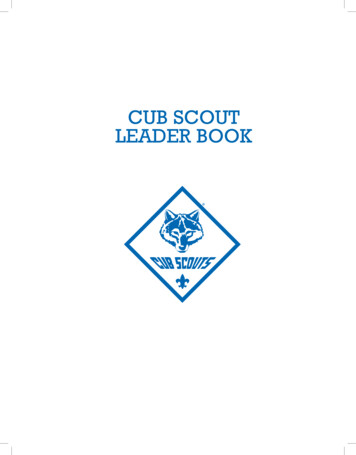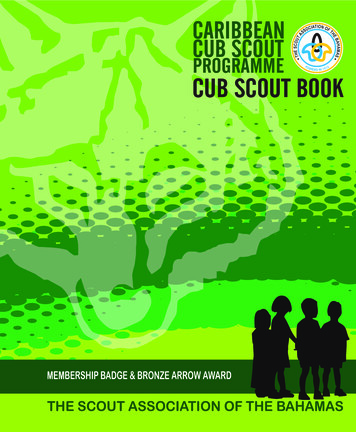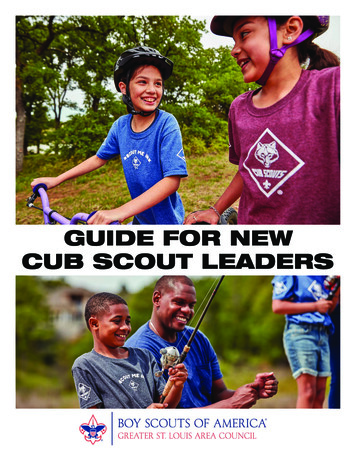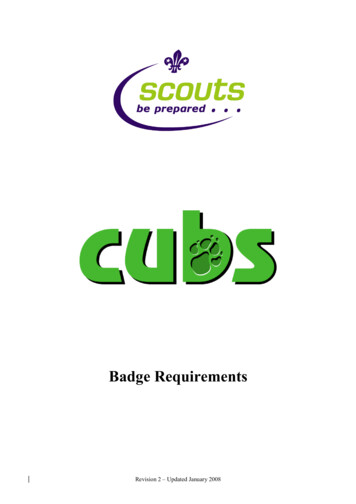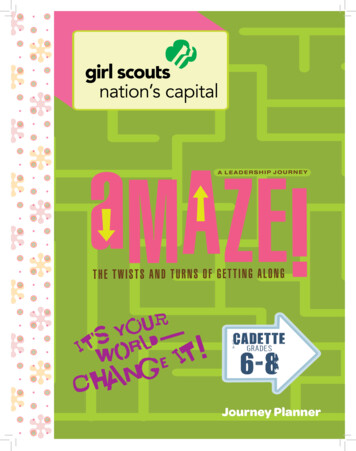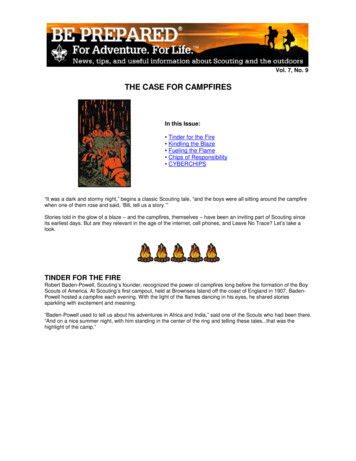
Transcription
Vol. 7, No. 9THE CASE FOR CAMPFIRESIn this Issue: Tinder for the Fire Kindling the Blaze Fueling the Flame Chips of Responsibility CYBERCHIPS“It was a dark and stormy night,” begins a classic Scouting tale, “and the boys were all sitting around the campfirewhen one of them rose and said, ‘Bill, tell us a story.’”Stories told in the glow of a blaze – and the campfires, themselves – have been an inviting part of Scouting sinceits earliest days. But are they relevant in the age of the internet, cell phones, and Leave No Trace? Let’s take alook.TINDER FOR THE FIRERobert Baden-Powell, Scouting’s founder, recognized the power of campfires long before the formation of the BoyScouts of America. At Scouting’s first campout, held at Brownsea Island off the coast of England in 1907, BadenPowell hosted a campfire each evening. With the light of the flames dancing in his eyes, he shared storiessparkling with excitement and meaning.“Baden-Powell used to tell us about his adventures in Africa and India,” said one of the Scouts who had been there.“And on a nice summer night, with him standing in the center of the ring and telling these tales.that was thehighlight of the camp.”
Early supporters of Scouting in America had a similarly positive view ofcampfire experiences and what the lack of them would mean to the outdoorexperience. The 1910 “original edition” of the BSA’s Official Handbook had asection entitled The Magic of the Camp-fire.“What is a camp without a camp-fire?” the book asked. “No camp at all, but achilly place in a landscape, where some people happen to have some things.”A decade later, the BSA published The Boy Scouts Book of Campfire Stories. “The campfire for ages has been theplace of council and friendship and story-telling,” wrote Chief Scout Librarian Franklin Mathiews. “The mystic glowof the fire quickens the mind, warms the heart, and awakens memories of happy, glowing tales that fairly leap tothe lips.”
Mathiews goes on to explain that “The Boy Scouts of America has incorporated the ‘campfire’ in its program forcouncil and friendship and story-telling.”
KINDLING THE BLAZEThe principles of Leave No Trace discourage campfires except where they will cause no harm to the environment.That eliminates them from many backcountry settings. A frontcountry site such as a BSA council camp that has firerings providing the ideal settings for evening campfires that fit Leave No Trace guidelines.A campfire can be a quiet affair with just a few people, or a big event with a program planned for dozens of Scoutsor more.A lodge firelay is often the choice for an evening campfire. It looks good before it is lit, a consideration for programswhen Scouts will arrive before a match has touched the tinder. Those building the firelay should use plenty of tinder
and kindling so there’s no doubt the fire will burn. Additional fuel wood nearby can be used to adjust the level of theflames through the evening.FUELING THE FLAMEA small group might be satisfied visiting as they watch a campfire turn to coals. A more formal program couldinclude stunts, skits, songs, and stories presented by some or all of the Scouts present.Big campfires are opportunities for youth leaders to practice planning a program, organizing presenters, andperforming in front of an audience. Plenty of preparation insures that stories, skits, and songs aren’t too long and
that they hold the interest of everyone. Many campfires end with a Scoutmaster’s Minute – a story from the troop’stop adult leader that inspires listeners with a memorable message.These books from scoutstuff.org offer ideas for preparing exciting campfire programs:
CHIPS OF RESPONSIBILITY
Scouting has always taught Scouts to make gooddecisions about building campfires and using knives,axes, and saws. It is a quest that goes back as far asRobert Baden-Powell and his sketch of Tommy theTenderfoot. Baden-Powell writes that:Poor Tommy’s forgotten to sharpen his axe, So the treeonly suffers a series of whacks.Today, the BSA recognizes those who learn and practice proper use of woods tools and of open fires. The oldestaward is the Totin’ Chip, devised by John Page, a Scouter who would one day become the director of the EditorialDivision of the BSA’s National Office.Mr. Page was dismayed that trees at Yawgoog Scout Reservation in Rhode Island were being hacked by Scoutswielding hatchets. He proposed the Totin’ Chip as a way for Scouts to earn the right to use woods tools. In 1951,BSA’s National Council adopted the Totin’ Chip for all Boy Scouts.The Whitlin’ Chip followed, offering Cub Scouts a patch and card for learning responsible use of a pocketknife.
There is also a Firem’n Chit to heighten awareness of whether to light a campfire and then how to care for it.A recognition for Scouts who have already earned the Totin’ Chip is the Paul Bunyan Woodsman award.Requirements include helping others earn the Totin’ Chip; using woods tools to clear trails or fire lanes; trimming,cutting up, and stacking a downed tree; and helping complete a planned conservation project.
The Paul Bunyan Woodsman patch is a BSA designated equipment decoration. (Other equipment decorationsinclude the 50-Miler Award and BSA Mile Swim.) While it cannot be worn on a BSA uniform like a temporary patch,an equipment decoration can be stitched to a blanket, tent, or vest, or attached to a piece of gear.From Cub Scouts pocketing their first knives to Scout trail maintenance crews using crosscut saws, Scouting’semphasis on wise tool use is long and rich.
CYBERCHIPSNot all chips granted by the BSA are about axes, knives, fires, and saws. The Cyber Chip encourages Scouts toexplore appropriate ways to navigate the internet. Patches and certificates show that Scouts have thought abouttheir online activities and strive to make the most of opportunities for safe, productive internet use.
What hasn’t changed in this age of computers and cell phones is the joy of a good campfire, built in the right placeand managed in the right way. With warmth and light, it can be a high point of many Scout outings today, just as ithas been through the decades.
(This edition of the Be Prepared Newsletter was developed and written by Robert Birkby, author of the currenteditions of the Boy Scout Handbook, Fieldbook, Scout Stuff, The Conservation Handbook, and Eagle Scouts: ACentennial History.)
A decad e later, the BSA published The Boy Scouts Book of Campfire Stories. “The campfire for ages has been the place of council and friendship and story-telling,” wrote Chief Scout Librarian Franklin Mathiews. “The mystic glow of the fire quickens the mind, warms the heart, and awa

